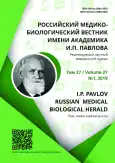Комплексная оценка степени тяжести ХОБЛ на амбулаторно-поликлиническом приеме
- Авторы: Низов А.А.1, Ермачкова А.Н.1,2, Абросимов В.Н.1, Пономарёва И.Б.1
-
Учреждения:
- Государственное бюджетное образовательное учреждение высшего профессионального образования Рязанский государственный медицинский университет имени академика И.П. Павлова
- ГБУ РО Поликлиника №12
- Выпуск: Том 27, № 1 (2019)
- Страницы: 59-65
- Раздел: Оригинальные исследования
- URL: https://journal-vniispk.ru/pavlovj/article/view/11500
- DOI: https://doi.org/10.23888/PAVLOVJ201927159-65
- ID: 11500
Цитировать
Аннотация
Цель. Анализ возможности и целесообразности комплексной оценки клинического состояния пациентов с хронической обструктивной болезнью легких (ХОБЛ) на амбулаторно-поликлиническом приеме в условиях небольшой территориальной городской поликлиники.
Материалы и методы. Исследование проводилось на базе ГБУ РО Поликлиника №12 г. Рязани с октября 2012 по декабрь 2014 г. При сборе анамнеза оценивали наследственную отягощенность, наличие неблагоприятных факторов, способствующих развитию и прогрессированию заболевания, кашлевой анамнез, фазу заболевания, наличие специфической медикаментозной терапии, далее проводилось скрининговое эпидемиологическое исследование (анкетирование). В результате, из обратившихся за медицинской помощью пациентов с хроническими респираторными симптомами (кашель, одышка) сформирована группа наблюдения (n=150, возраст 19-81 лет, средний возраст 56,1±2,3 лет), в которой выполнялась скрининговая спирография, проведена оценка степени тяжести ХОБЛ согласно GOLD 2014, сформированы группы наблюдения: A, B, C, D.
Результаты. В группе наблюдения ХОБЛ была подтверждена в 100% случаев, из них 1-я стадия ХОБЛ – 18,7%, 2-я – 43,3%, 3-я – 30,0 %, 4-я стадия – 8,0%. Количество обострений составляло 1-8 в год. Наиболее частыми сопутствующими заболеваниями были: ишемическая болезнь сердца (53,2%), артериальная гипертония (74,3%), хронический гастродуоденит (34,5%). В 31,3% случаев отмечалось сочетание ≥2-х хронических заболеваний. В зависимости от степени ограничения скорости воздушного потока и симптомов заболевания, истории обострений, больные были распределены на следующие группы по GOLD 2014: группа А – 39,3%, группа B – 20,0%, группа C – 19,0%, и группа D – 21,7%. По возрасту, полу и статусу курения статистически значимых различий между группами выявлено не было (p>0,05).
Выводы. Проведенный анализ продемонстрировал возможность и удобство использования стратификации пациентов с ХОБЛ по степени тяжести заболевания (согласно GOLD 2014) с целью индивидуализации дальнейшего ведения таких пациентов.
Ключевые слова
Полный текст
Открыть статью на сайте журналаОб авторах
Алексей Александрович Низов
Государственное бюджетное образовательное учреждение высшего профессионального образования Рязанский государственный медицинский университет имени академика И.П. Павлова
Автор, ответственный за переписку.
Email: anna.vyunova@bk.ru
ORCID iD: 0000-0001-7531-9102
SPIN-код: 2939-8193
ResearcherId: M-7081-2018
д.м.н., профессор, заведующий кафедрой внутренних болезней, Рязанский государственный медицинский университет им. акад. И.П. Павлова
Россия, 390026 г. Рязань, ул. Высоковольтная, д. 9Анна Николаевна Ермачкова
Государственное бюджетное образовательное учреждение высшего профессионального образования Рязанский государственный медицинский университет имени академика И.П. Павлова; ГБУ РО Поликлиника №12
Email: anna.vyunova@bk.ru
ORCID iD: 0000-0002-2770-3414
SPIN-код: 7073-2120
ResearcherId: D-7935-2018
аспирант кафедры внутренних болезней; врач терапевт
Россия, 390026 г. Рязань, ул. Высоковольтная, д. 9; РязаньВладимир Николаевич Абросимов
Государственное бюджетное образовательное учреждение высшего профессионального образования Рязанский государственный медицинский университет имени академика И.П. Павлова
Email: Kosyakov_alex@rambler.ru
ORCID iD: 0000-0001-7011-4765
SPIN-код: 3212-4620
ResearcherId: X-2649-2018
д.м.н., профессор, заведующий кафедрой терапии и семейной медицины ФДПО с курсом медико-социальной экспертизы
Россия, 390026 г. Рязань, ул. Высоковольтная, д. 9Ирина Борисовна Пономарёва
Государственное бюджетное образовательное учреждение высшего профессионального образования Рязанский государственный медицинский университет имени академика И.П. Павлова
Email: Kosyakov_alex@rambler.ru
ORCID iD: 0000-0002-0273-4388
SPIN-код: 3984-1944
ResearcherId: D-6849-2018
к.м.н., ассистент кафедры терапии и семейной медицины ФДПО с курсом медико-социальной экспертизы
Россия, 390026 г. Рязань, ул. Высоковольтная, д. 9Список литературы
- Carone M., Antoniu S., Baiardi P., et al. Predictors of Mortality in Patients with COPD and Chronic Respiratory Failure: The Quality-of-Life Evaluation and Survival Study (QuESS): A Three-Year Study // COPD Journal of Chronic Obstructive Pulmonary Disease. 2015. Vol. 13, №2. P. 1-9. doi:10.3109/ 15412555.2015.1067294
- Loddenkemper R., editor. European Lung White Book. The first comprehensive survey on respiratory health in Europe. 2003.
- van der Molen T., Miravitlles M., Kocks J.W. COPD management: role of symptom assessment in routine clinical practice // International Journal of Chronic Obstructive Pulmonary Disease. 2013. Vol. 8. P. 461-471. doi: 10.2147/COPD.S49392
- Cazzola M., MacNee W., Martinez F.J., et al. Outcomes for COPD pharmacological trials: from lung function to biomarkers // European Respiratory Journal. 2008. Vol. 31, №2. P. 416-469. doi:10.1183/ 09031936.00099306
- Tsiligianni I.G., van der Molen T., Moraitaki D., et al. Assessing health status in COPD. A head-to-head comparison between the COPD assessment test (CAT) and the clinical COPD questionnaire (CCQ) // BMC Pulmonary Medicine. 2012. Vol. 12. P.20. doi: 10.1186/1471-2466-12-20
- Котляров С.Н. Скрининг спирометрии в оценке хронической обструктивной болезни легких на уровне первичного звена медицинской помощи // Российский медико-биологический вестник имени академика И.П. Павлова. 2011. Т. 19, №1. С. 91-95.
- Абросимов В.Н., Шутов А.В. Комплексная оценка действия ипратропиума бромида у больных хронической обструктивной болезнью легких // Российский медико-биологический вестник имени академика И.П. Павлова. 2004. №3-4. С. 181-185.
- Пономарева И.Б., Субботин С. В. Возможности метода объемной капнографии в изучении легочных функций у больных ХОБЛ // Наука молодых (Eruditio Juvenium). 2016. №1. С. 68-73.
Дополнительные файлы








